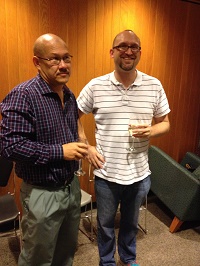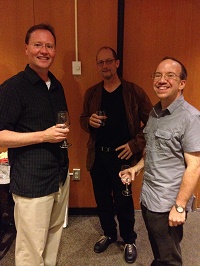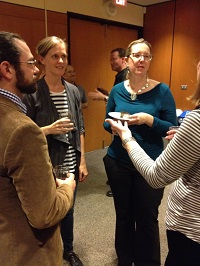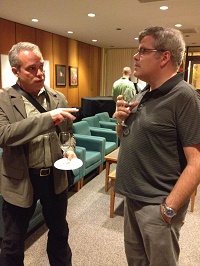2015 York Christian Apocrypha Symposium: A Postmortem (Part 1)
It has become tradition to offer some postmortem comments about the York Christian Apocrypha Symposium here on Apocryphicity. It helps me gather my thoughts about the event while everything is still fresh. I present these comments in three separate posts.

The first day of the 2015 York Christian Apocrypha Symposium was the culmination of a year of planning that began with Brent Landau and I thinking up a theme for the event. Bart Ehrman’s Forgery and Counterforgery volume had recently been published and there was still plenty of buzz happening about the Gospel of Jesus’ Wife. We thought these could act as pillars for a theme of composing Christian Apocrypha through the ages. I came up with the title “Fakes, Fictions, Forgeries,” cribbing it from a sentence in my book Secret Scriptures Revealed; Brent thought it a little negative toward the texts but we figured it would suffice through the planning stages and, as these things happen, it stuck. I feared that the ever-busy Ehrman would decline our invitation to give the symposium’s keynote address but, to our surprise, he accepted, even waiving his usual appearance fee (a considerable sum at $5000, which he donates to charity).

The course of debate about the Gospel of Jesus’ Wife at the time was leaning toward modern composition, though with a year to go before the symposium, anything could happen. It seemed safer to steer clear of questions of authenticity and look instead at how the text was being discussed in the field. Janet Spittler had been involved in the heated discussion over Christian Askeland’s ill-chosen analogy about the text (Askeland’s blog post entitled “Jesus Had an Ugly Step-sister”—later changed to “Jesus had a Sister-in-Law”—employed arguably sexist language in using, in Eva Mroczek’s words, “an ugly woman as a metaphor for a sloppy, forged, worthless text”). We asked Janet to help organize the panel and to offer a response to the panelists. Before long we had recruited Carrie Schroeder, Mark Goodacre, and James McGrath.
Several other scholars were invited to present papers, including Alin Suciu for his work on Coptic Pseudo-Apostolic Memoires and Laurie Maffly-Kipp, the editor of a recent collection of modern American apocrypha. We also issued, for the first time, an open call for papers and specified that papers from graduate students also would be accepted. Previous York symposia had demonstrated to us that a large number of those who attended these events were graduate students, so we wanted to offer them opportunities to present their work. In the end we accepted three proposals from among the graduate student pool—by Bradley Rice, Gregory Fewster, and Ross Ponder—because their proposals best fit the theme of the symposium.

So we were on our way. October 2014 came around and I got down to business writing funding applications. The 2013 symposium was supported by a generous government grant and several smaller commitments from various York research funding bodies. I went knocking on the same doors, prised a good chunk of cash out of the university and waited for the government funding to come rolling in.
For a reason I cannot fathom, the government funding did not come through. We were faced with cancelling the symposium. Then Pierluigi Piovanelli suggested asking the presenters to fund their own travel. To my surprise, virtually everyone was able to do so. It was gratifying to see such support for the symposia. We lost a few of our presenters, including Suciu and Maffly-Kipp, but with some minor adjustments the symposium was saved from the jaws of death.
As the date of the symposium approached, we had another few of our presenters—Annette Yoshiko Reed and Paul Dilley—pull out of the event because of changes made to other, overlapping commitments. This meant we lost two of our late-antique apocrypha papers. We scrambled to find replacements who could quickly come up with something to fit the theme of the symposium. To our delight Scott Brown and Eric Vanden Eykel were able to join the program with papers for the modern apocrypha panel. So, again with a few adjustments, we had a final program that still reflected the symposium’s guiding theme.

Now all we had to do was get everyone to campus (via planes, trains, and automobiles), arrange for accommodations, throw together a reception on-the-cheap, and a nice formal dinner, all with a relatively small budget. I recruited a few drivers—Peter Dunn and Joe Oryshak—to share the pickups from the airport , and a few students—Ryan Belluz and Hana Kahn—to work the door and co-ordinate catering. All the flights came in on time save one: Bart Ehrman was delayed twice, which meant our planned wining-and-dining of our keynote speaker ended up being a quick-and-dirty stop at Thai Express (classy!) to wolf down some quickly-prepared and scalding-hot Pad Thai before rushing to the opening reception.
The reception provided an opportunity for all of the presenters to meet one another, some of us for the first time, in an informal setting. We had some drinks and nibblies (note for the future: more wine, less nibblies) and shared stories of our summer escapades before heading off to the on-campus hotel to (in my case, but likely for several others too) put the finishing touches on our presentations and read as many of the drafts as possible before the official opening of the symposium Friday morning.
To be continued…
P.S. For James McGrath’s account of his pre-symposium travels and our gathering see his post on Exploring Our Matrix.
